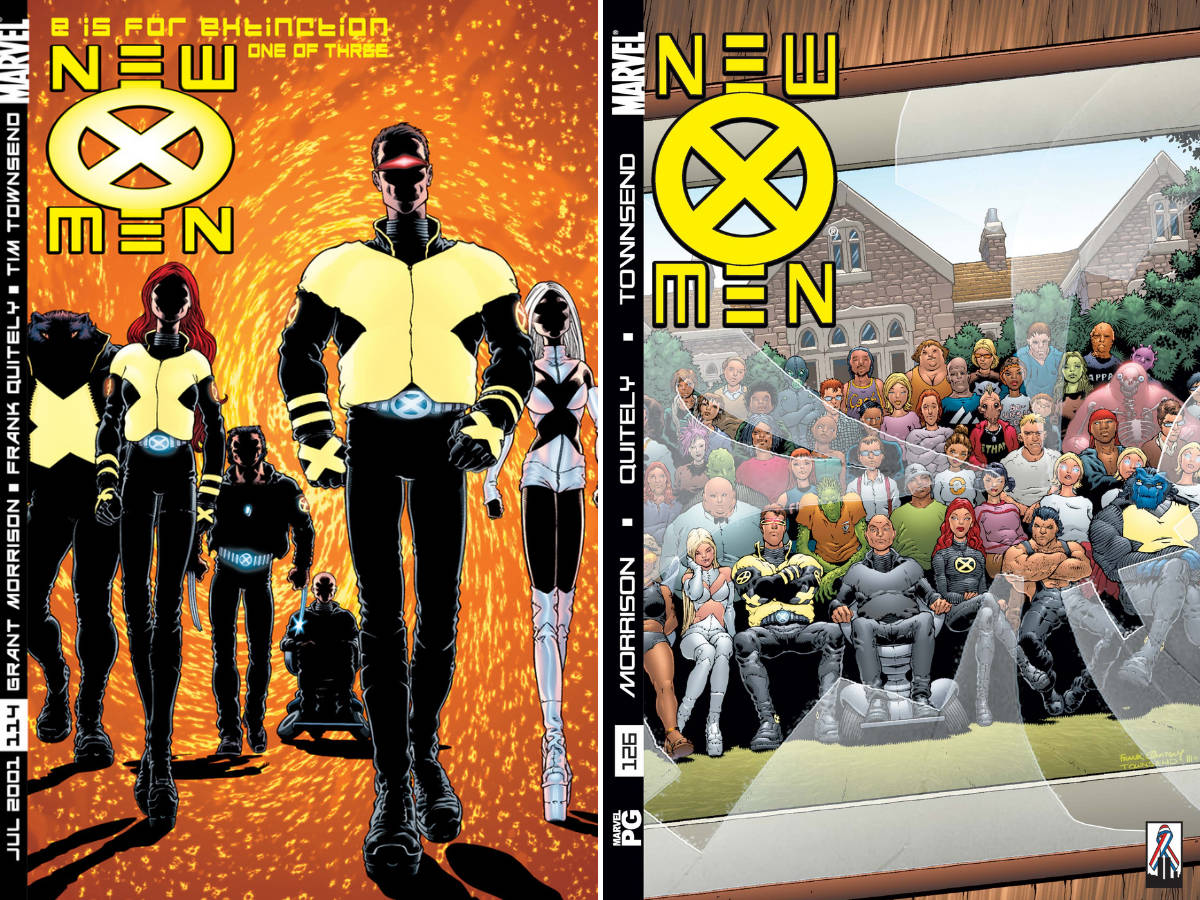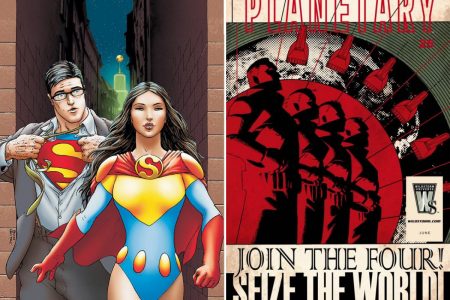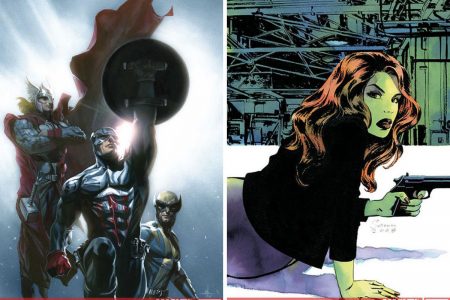I quit the X-Men shortly after Chris Claremont left in 1991 (when he discovered that all the hard work he had put into The Uncanny X-Men didn’t mean a thing to the editors who preferred hot artists doing their versions) having being a devout X-fan since I’d discovered them. I stayed away, even avoiding my favourite artist, Alan Davis. It was going to take something spectacular to bring me back. Grant Morrison was that something spectacular.
Beginning with E is For Extinction (issues #114–116), he produced the goods straight away. This exquisite little story has the classic ‘everything you know is wrong’ conceit of Charles Xavier’s twin sister, Cassandra Nova, as a starting point, and just got better. Grant understood the X-Men better than anybody has in a long while. His definition of characters, in the most succinct and pure manner, was a delight, with an economy of dialogue and action. Matched with Frank Quitely’s beautiful and unique art style, the X-Men were back and better than ever (even if I didn’t like the Emma Frost costume as a functional and viable outfit, especially as he put everyone else in such sensible leathers). Not only is it a cracking little tale, it also played to the theme of the X-Men, and set up future stories in its wake.
Chronologically, the next issue was Annual 2001, with stunning Yu artwork. I’m not sure if the widescreen experiment works, but the story does play well into the cinematic action idea, and we get some old-fashioned X-Men fun, with the introduction of the V-Men and Xorn, who would play such an important part in the overall story.
It was inevitable that things might never be as good as this again, but such is life. Issue 117 had Ethan van Sciver on art duties. He has a polished, modern superhero style, but not in the same league as Quitely. This issue saw the school brought to the foreground again, and the beating of the Beast. Issues 118–20 (Germ-free Generation) sees a mix of Sciver and Igor Kordey art (#119 has the infamous Emma camel toe), with Kordey’s art coming off particularly badly (he was rushing work to finish it in crazy deadlines rather than producing quality work, a regrettable occurrence that spoils the early stories when re-read). However, the delicious dialogue from Grant more than makes up for it, as he weaves more story magic with the team. Issue 121 is the ‘Nuff Said story, the silly gimmick from Bill Jemas, forcing the creators to have a story with no words. Morrison and Quitely produce the best of these, with a visually stunning and genuinely inventive tour inside Xavier’s mind.
 The ‘Imperial’ storyline began in #122 (a delight seeing Quitely drawing the Imperial Shiar Guard), as the body of Xavier (but the mind of Nova) takes some time with the Shiar, only for things to go badly awry. The dialogue still sings (Emma gets all the best lines: “We must be nothing less than fabulous.”) and the story ramps up. Van Sciver takes #123, with the teleconference and arrival of the Guard, but is followed by the rushed Kordey art on #124 and 125, ruining the coolest parts of the story, with the Guard attacking the X-Men and their subsequent fightback. However, #126 is a double-sized issue packed with Quitely sumptuousness, with blistering action, cool banter (“Scott. You’re my favourite superhero.”) and the great idea of storing Charles’s brain in everyone, prior to a nice Silver Age finish.
The ‘Imperial’ storyline began in #122 (a delight seeing Quitely drawing the Imperial Shiar Guard), as the body of Xavier (but the mind of Nova) takes some time with the Shiar, only for things to go badly awry. The dialogue still sings (Emma gets all the best lines: “We must be nothing less than fabulous.”) and the story ramps up. Van Sciver takes #123, with the teleconference and arrival of the Guard, but is followed by the rushed Kordey art on #124 and 125, ruining the coolest parts of the story, with the Guard attacking the X-Men and their subsequent fightback. However, #126 is a double-sized issue packed with Quitely sumptuousness, with blistering action, cool banter (“Scott. You’re my favourite superhero.”) and the great idea of storing Charles’s brain in everyone, prior to a nice Silver Age finish.
Issue 127 sees the start of what the TPB calls ‘New Worlds’ stories. John Paul Leon provides some nicely moody artwork in what is seen in hindsight as a great bit of misdirection on Morrison’s part, as we get a story about Xorn. Next, we have the horrible Kordey art as we are introduced to X-Corporation Europe (a great idea from Morrison), and then Fantomex (or Weapon XIII), who is not quite as cool as Morrison thinks, but does provide impetus for an intriguing adventure. Fortunately, issue 131 sees the return of Leon on pencil duties (inked by the legend that is Bill Sinkiewicz), and the beginning of the mental affair between Scott and Emma. Issue 132 sees some old school superhero art in the form of quality ink jockey, Phil Jiminez. His Perez inspired detailism and background-it is sees lovely throwaway bits (like Jean and Ororo hugging in the background of a panel). He draws beautiful women, with naked Lorna being a piece of sly covering with shadows (although he doesn’t bother by the end of the panels, and you can tell she’s had a Hollywood). Issue 133 is a jumbled issue – Logan in Afghanistan, Xavier stopping a mid-air plane hijack, an assassination attempt by Lilandra (after the Nova incident), old X-Force people turning up, and meeting Sooraya, the female Muslim superhero. That must look quite strange in the trade.
Issue #134, the prologue to ‘Riot At Xavier’s’, has Keron Grant bringing a more modern style to an unexceptional issue. Issues #135–8 sees the long-awaited return of Quitely, bringing his distinctive and warped beauty artistry to a powerful tale. There’s a bit of a Clockwork Orange/If… riff going on, and it’s not typical X-Men fare, but that’s what makes it interesting. The details are great (the ‘Magneto was right’ t-shirt, the headmaster’s office) and one has to admire the enthusiasm of the story. Although I don’t like the little goatee thing on Logan on the cover, but not in the issue itself. In issue #136, the special class is attacked, and we get the lovely line, “A smart fart.” Next issue has Quentin Quire taking over the school, with Scott coolly taking on the rioters: “Student performance evaluation. Grade: poor.” The final issue, with Quitely’s perfect rendition of Hank McCoy, and Xorn killing Quire (but why does he do it, we think with hindsight). And for the fanboys, Emma in the Phoenix costume and red hair, unzipping it seductively … ggggrrrrooowwwlll.
‘Murder At The Mansion’ is a three-part tale told in issues #139–141. It starts with a beautiful cover from Jiminez, who provides art for the story – all you need for a stand-out cover is two hot women looking gorgeous, no background, just white space to highlight the two characters. Very sexy. This is a fun whodunit, with the great last page showing a shattered Emma in her diamond form. Another great cover adorns #140, Jiminez channelling his inner Perez with the group shots. Inside, Grant makes Bishop and Sage cool, which shows you how good he is. More great dialogue and the Beast putting Emma back together. This is completed in #141, with Phoenix completing the job (after reading Henry’s brain’s medical books), underneath a Terminator homage cover.
 Issues #142–145 sees Chris Bachalo drawing the X-Men for the ‘Assault On Weapon Plus’ storyline. Bachalo has been getting progressively more experimental in his panel choice and page layout, which gets in the way of clear storytelling, but he keeps it to a minimum, showcasing his talents as an artist. Grant does a nice bit of exploration of X-Men psyche through conversation, as Scott and Logan chat about relationships (in the Hellfire Club, now a mutant private club, which is a nice idea) and Logan talks him into a mission with him and Fantomex. Grant nails these characters, especially Scott, doing the impossible and making him an interesting character. In #143, under a great cover, Grant mixes AIM science to make England “a square mile of experimental micro-reality”, which brings a smile to my face just writing it. Bachalo loses some of the discipline in where he places the camera for action scenes in this issue, which makes things confusing while still being pretty. The only problem with the storyline is the lack of conviction in the Weapon Plus concept (Captain America as Weapon I?) that prevents it from being completely engaging, albeit still entertaining.
Issues #142–145 sees Chris Bachalo drawing the X-Men for the ‘Assault On Weapon Plus’ storyline. Bachalo has been getting progressively more experimental in his panel choice and page layout, which gets in the way of clear storytelling, but he keeps it to a minimum, showcasing his talents as an artist. Grant does a nice bit of exploration of X-Men psyche through conversation, as Scott and Logan chat about relationships (in the Hellfire Club, now a mutant private club, which is a nice idea) and Logan talks him into a mission with him and Fantomex. Grant nails these characters, especially Scott, doing the impossible and making him an interesting character. In #143, under a great cover, Grant mixes AIM science to make England “a square mile of experimental micro-reality”, which brings a smile to my face just writing it. Bachalo loses some of the discipline in where he places the camera for action scenes in this issue, which makes things confusing while still being pretty. The only problem with the storyline is the lack of conviction in the Weapon Plus concept (Captain America as Weapon I?) that prevents it from being completely engaging, albeit still entertaining.
And so we come to issue #146, the start of the 6-part ‘Planet X’ storyline and the notorious reveal of Xorn’s true identity, which Marvel seem to be ignoring and actively changing. The concept of Magneto masquerading as a mutant with a sun for a brain is brilliant – funny, clever and wonderfully Silver Age yet modern. Grant Morrison is the man, planning this from the beginning. Phil Jiminez is back for the art on these issues, bringing a sharp-lined clarity to the destruction and madness within. Lovely dialogue filters throughout (“Since when did a good education and an extensive vocabulary become handicaps?” “Nazis? Do I look like a failed artist with a neurotic grudge against his father and the world?”), there is lots of explodo (New York in particular gets a beating), Magneto goes nuts, twists keep coming, and coolness abounds in a spectacular X-Men adventure using the two (of the three) continual tropes of the mutant books – Magneto and Phoenix.
The final trope of the mutant books – alternate futures – is found in the last storyline by Grant in issues #151–154, with art by Marc Silvestri. For my sins, I like Silvestri’s art, the way it looks like it has just been sketched but is actually quite detailed, even if he does have weaknesses as an artist. The cover to 151 shows that it’s not just women who are forced to butt shots on the front of comics to sell them. And Grant puts the word ‘wanker’ into an X-Men book, just to make me smile with happiness. Being the future, Grant can not only follow through in his wonderfully mad ideas (and they don’t seem out of place) but he can also do whatever he wants as well. I particularly love the apparently evil Beast in Transatlantis creating chimeras of the entire mutant genebase – how cool is that? Nightcrawlers with Cyclops and Multiple Man traits – fucking excellent! Grant has fun with this story – Logan is naturally alive in this future (as well as others); things looking bleak for the mutants; the Phoenix egg; Hank subsumed by smart bacteria in the aerosol form of Kick, Sublime; changing the past; multiple Phoenixs; and saving an orphan universe. Now that’s going out with a bang. It’s not perfect by any means, but what an exit. Shamefully, Marvel chose to ignore Grant’s breath of fresh air to the mutant universe, but it was fun while it lasted. For 42 issues, I could read the X-Men again, with the same enthusiasm and joy of a youngster, and I am grateful for that.





I have gone back and looked at the Annual, and I’m still convinced that Morrison didn’t have Magneto in mind when he first introduced Xorn, but decided on it later. Some day I’ll have to scour the issues for clues, but for now, I remain unconvinced.
Good overview, though. Makes me want to re-read them now.